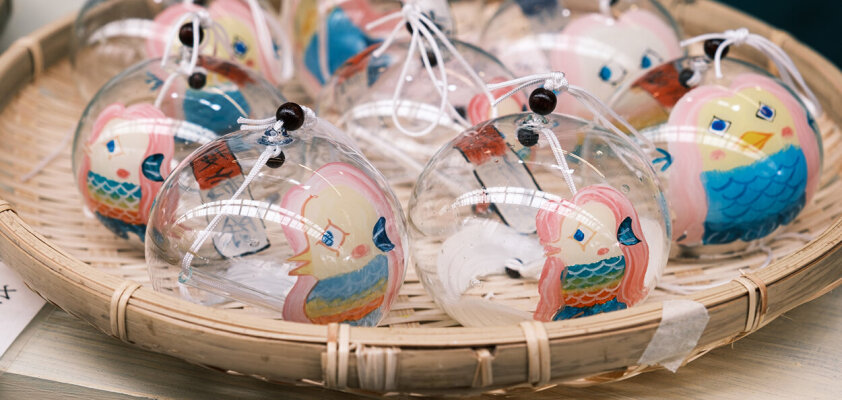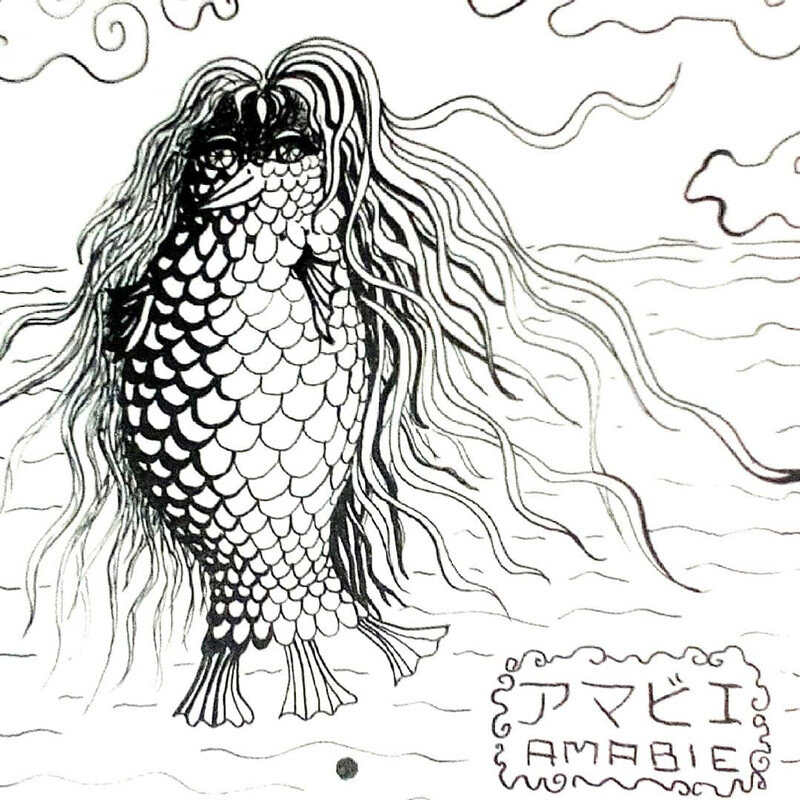Amabie - A Protective Mythical Creature

Inhaltsverzeichnis
Traditions in Japan Drawing Amabie by Catrin Mansel Development in the 20th centuryThe Japanese legend of Amabie revolves around a mysterious mythical creature. It is said to have emerged from the sea and only appears to people on specific occasions. Amabie has three legs, a fish-like body, and very long hair that reaches down to its feet. In a woodcut from the year of its first appearance, its head is shaped like that of a bird with a pointed beak. People tell the story that this hybrid creature appeared on the shores of Kumamoto in the Higo Province in the Kōka-3 year of the Edo period, which corresponds to the years 1847 or 1848 in our calendar. Kumamoto Prefecture is located on the island of Kyūshū in the south of Japan.
For several nights, a strange glow in the sea could be seen from the beach. To investigate, a city official went to the shore and observed the water. After some time, Amabie came to the shore and spoke to him. It predicted a good harvest for the next six years. Then, it instructed the official to draw an image of it. This illustration was to be shown to the people when a disease spread, so that they would be healed by looking at it. It returned to the sea, and the official had an artistic woodcut of its figure made. It was published along with a print of the story in the newspaper, making it known throughout Japan.
Traditionen in Japan
The name Amabie or Amabiko is formed from the two syllables Ama and Biko, which can be translated as "heaven" and "revered son." In the context of the legend, the designation "Heavenly Messenger" or "Messenger of the Sea" would be plausible.
In Japan, spirits and demons from nature are called Yokai. They live in the sea, on a mountain, or among people. Some are said to resemble an animal, while others can change their shape and sometimes appear as a human or household objects. Certain Yokai possess tremendous powers and are believed to be invulnerable.
Japanese tradition has a close connection to fantastical beings and stories about the spirit world. Many animals are attributed magical powers or embody deities. Animals like the fox, shark, wolf, or badger are considered magical. The fox can transform into a beautiful woman, using her cunning and deceit. These figures are often used as motifs in drawings and paintings. They appear in manga or provide inspiration for artists' new works. While superstition has no place in modern Japanese society, the Japanese have a fondness for their Yokai. They use them as mascots and incorporate them into encouraging gifts.
According to the legend, Amabie behaves positively towards the population by predicting abundant harvests and being able to ward off diseases with its image. It appeared several times throughout Japan later on. Its last sighting was recorded in 1876. In these sightings, the creature was depicted with an ape's body, squid tentacles, or a human head. All stories had in common the prediction of several years of good harvests and an impending epidemic. Images of these beings were intended as a remedy against the plagues. After that, there was silence around this figure for a long time, but it did not fade into complete oblivion.
Development in the 20th Century
Until 1870, the belief in Yokai was widespread among the Japanese people. With the onset of the Meiji era and the industrial revolution in Japan, more and more Western values and views spread, banishing spirits and demons as superstitions. However, myths and fairy tales persisted stubbornly among the population. In the early 20th century, the nation rekindled its focus on its historical identity. There was a return to the Bushido ethos, and attention was drawn to the mysterious beings that rural communities had always used as explanations for strange phenomena.
Occasionally, Amabie appeared in magazines. It was printed during a cholera outbreak in 1882 and on the eve of World War I in 1914. Newspapers included Amabiko supplements that people were supposed to put up at home. In the 1960s, artist Mizuki Shigeru started a manga series featuring various Yokai, later developing a comprehensive compendium of these figures, including Amabie. It made its first appearance in an anime in 2007. Mizuki Shigeru passed away in 2015, but his company continued the work.
In 2020, the Coronavirus spread worldwide. On March 17, 2020, Mizuki Productions tweeted from their company's social media account, sharing a photo of Mizuki Shigeru's Amabie illustration. The accompanying message read: "This is an 'Amabie.' We took a photo of Mizuki Shigeru's original drawing. It is ... closer to a divine being than a Yōkai. In the Edo period, it appeared ... and instructed: 'If the plague spreads, draw my picture and quickly show it to everyone.' ... May it free us from the current pandemic."
The response to this tweet was enormous. The news spread rapidly, and people around the world displayed the image as posters in their homes, on clothing, or even on masks as protection against Covid-19. While an image cannot fight a virus, it serves as a symbol of unity. It comes in many variations, illustrating hygiene rules against Corona on posters or simply having a cute form. Even the Japanese Ministry of Health used it as a logo for its campaign against the Covid-19 pandemic.
Many depictions largely adhere to the original woodcut from the 19th century. However, imaginative variations can be found in the childlike Kawaii style, as classical ink drawings, sculptures, crocheted Amigurumi, or wooden figures. Perhaps the massive appearance of Amabie also predicts good harvests for the coming years. That would be truly wonderful.












-from-the-yakiyaki-grill-pan.jpg)




